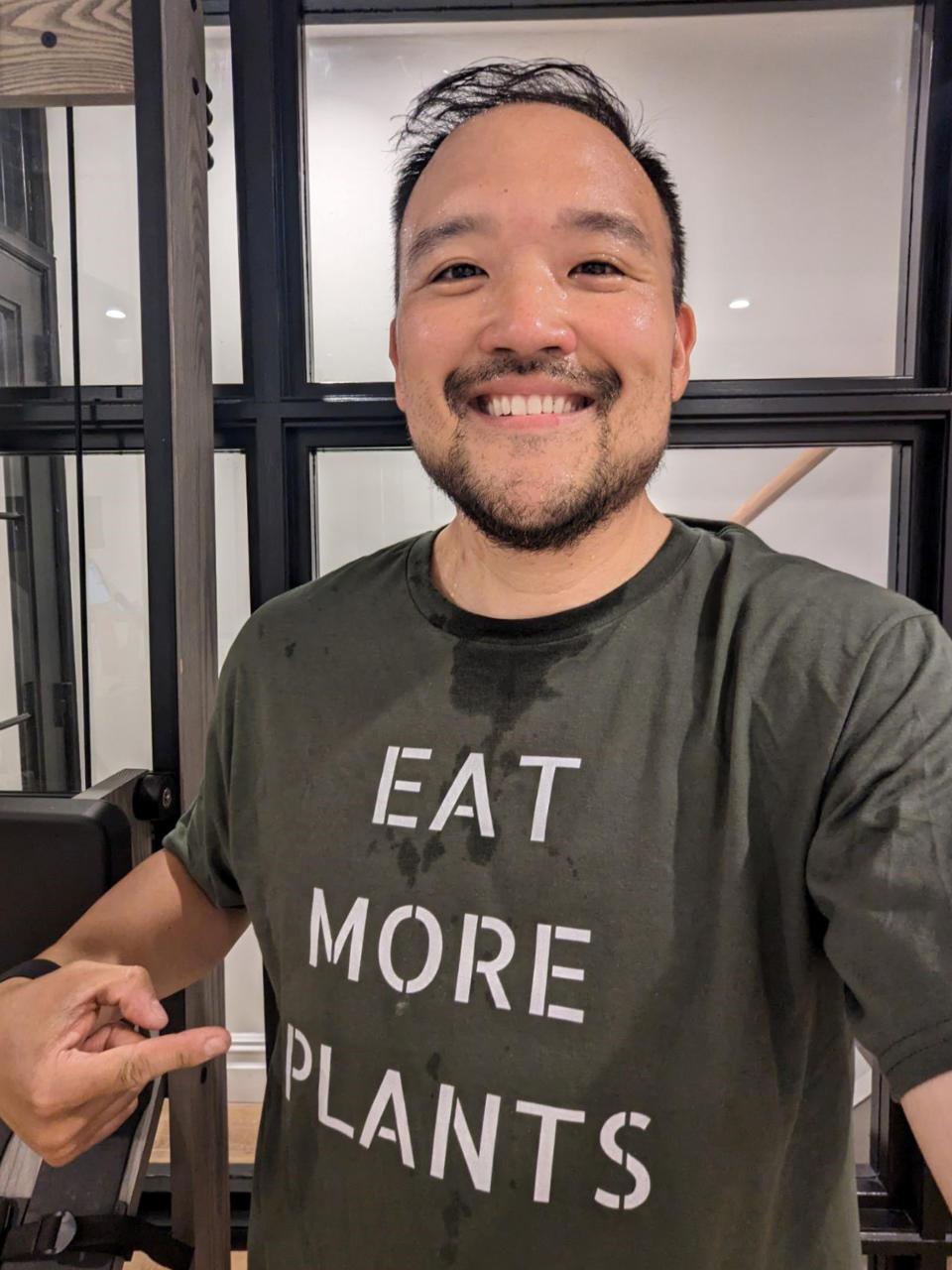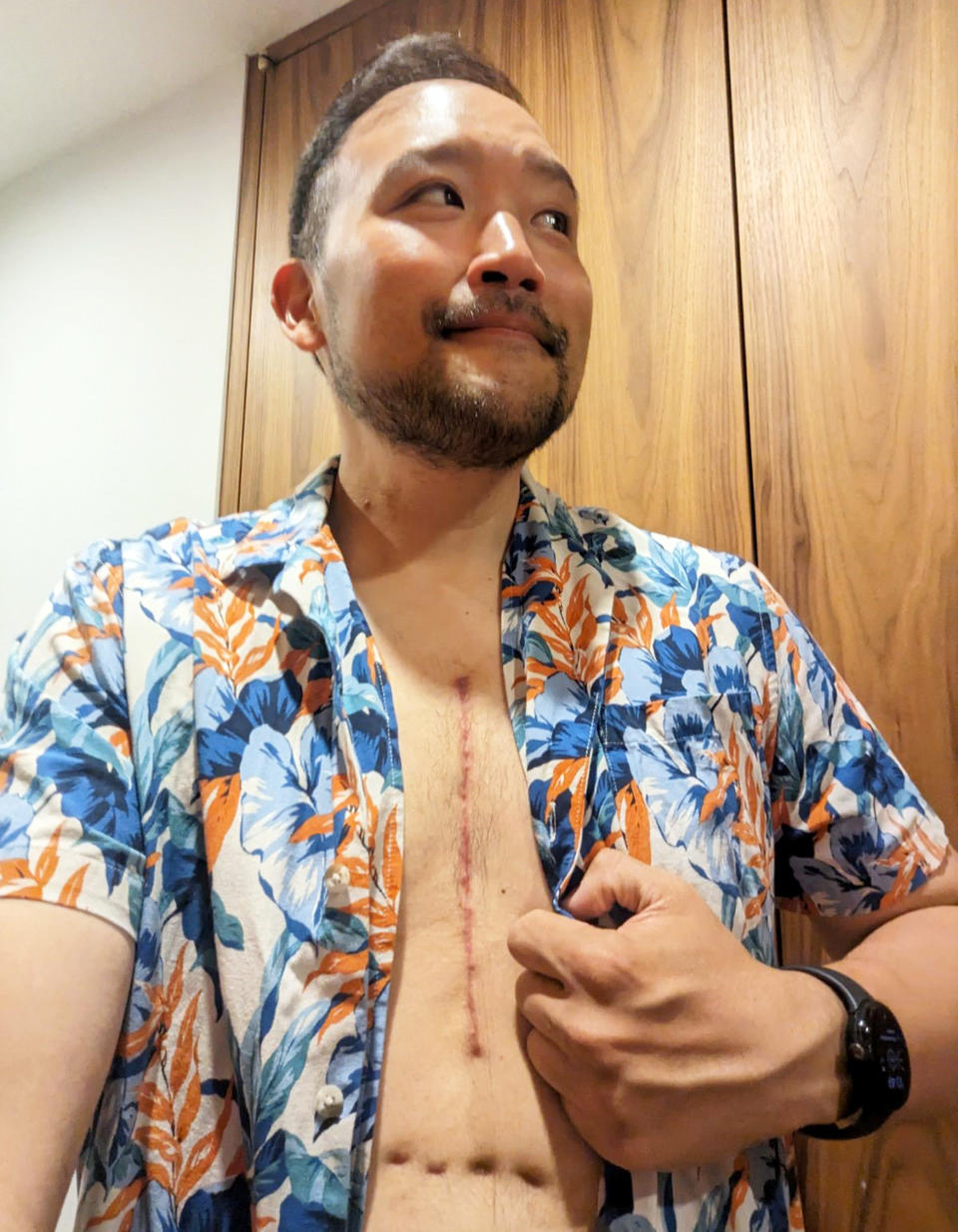Dad, 40, had no idea he had 5 blocked arteries. A checkup prevented a heart attack
- Oops!Something went wrong.Please try again later.
While on vacation with his wife last year, Peter Sunwoo heard about a healthy acquaintance who had a heart attack at 39 years old. He and a friend had just turned 40, so they decided to get their hearts checked — just in case.
Sunwoo's doctor appointment led to an early discovery of five extremely blocked arteries, and he underwent surgery to repair them before they caused a heart attack. His doctors couldn't point to a specific cause for the blockages, and Sunwoo didn't have any risk factors, so they speculated that it was likely genetic.
“Luckily, I found out just by chance,” Sunwoo, 41, of Brooklyn tells TODAY.com. “I’m an extremely unlucky person for even having this genetic thing, but at the same time, it’s being countered with being extremely lucky because my heart is in complete, functional condition.”
A check-up reveals an unknown problem
For much of his life, when Sunwoo ran, he felt a tightness in his chest. He thought running was supposed to feel uncomfortable.
“I always thought when you run you would have a chest tightness — that was always a norm for me. I never thought like, ‘Oh, this is a symptom,’” Sunwoo says. “I would cycle a lot or swim. ... Running was not my thing.”
Then, on a recent cruise with his wife and friends, Sunwoo and his friend thought they should undergo an examination of their heart health, especially because the acquaintance who had a heart attack seemed healthy and fit.
When Sunwoo went for his cardiac stress test, it revealed some abnormalities. Doctors recommended he undergo a CT scan, which showed a high calcium score. According to the American Heart Association, a calcium score gives doctors an understanding of how much calcium is in the arteries. The higher the score, the more severe the blockage is. A cardiologist reinforced the CT findings, locating five blocked arteries.

“Most people will find out (about blocked arteries) after a heart attack,” Sunwoo says.
He says that the severity of his blockages made doctors think that something underlying was going on in his body. He was eating fairly healthy and exercised regularly, recently losing about 50 pounds before his heart problems were discovered.
“It can’t be lifestyle is what the doctors (were) saying because there’s just nothing you could do to possibly get (a calcium score) that high,” he says. “I had no symptoms.”
Sunwoo met with Dr. John Puskas, chair of cardiovascular surgery at Mount Sinai Morningside, about bypass surgery. Finding his blocked arteries before a heart attack meant that Sunwoo’s heart muscle was still at full capacity, and undergoing a bypass would help keep it that way.
“The way Dr. Puskas has described it is my engine is perfectly fine, but the fuel lines are clogged," he says.
To help clear the blockages, Puskas performed bypass surgery on Sunwoo.
'Blockages are silent until they're not'
It’s common for people with heart disease to be unaware that something's wrong. Sometimes conditions such as high blood pressure or elevated cholesterol cause no symptoms.
“The blockages are silent until they’re not,” Puskas tells TODAY.com. “That sounds silly, but the blockages tend to develop that slowly. They develop because of the deposition of calcium and cholesterol in the walls of the arteries that feed the heart, narrowing the pathway down.”
Puskas says CT scans of the heart give doctors a good idea about artery blockage.
“Peter’s (calcium) score was 1,789. Normal is anything less than 10. So, 1,789 will put him in the highest top 1% or 2% for his age,” Puskas explains. “In fact, he had some damage to the pumping function of his heart even without him being unaware, which is a little unusual.”
Doctors aren’t exactly sure why Sunwoo experienced such severe blockages as a young age.
“He didn’t have a lot of other risk factors,” Puskas says. “We’re left with a bit of a mystery as to why this particular young man developed these blockages to such an extent in all of the arteries of his heart. When we don’t have a good thing to point the finger at, we blame the genes.”
Sunwoo’s chest pain while running was an early sign of heart troubles, which he did not realize. Still, he visited the doctor before anything catastrophic occurred.
“He came early, and he hadn’t suffered a big heart attack, and that’s terribly important because bypass surgery prevents another heart attack,” Puskas says. “It can’t undo a heart attack that’s already happened.”
Puskas preforms bypass surgery differently than many doctors. A heart bypass surgery involves taking a blood vessel — an artery or vein — from another part of the body and connecting it to the heart so blood can go around the blockage, according to the Mayo Clinic.
Traditional bypass surgery involves the use of a heart-lung machine (which takes over the function of the heart and lungs), a thin tube inserted into the heart, draining the heart of blood, clamping the aorta (the largest artery in the body) and an injection of a high potassium solution to stop the heart. But this type of procedure carries some risks, such as stroke or post-surgery cognitive decline.
Puskas does not use a heart-lung machine, nor does he insert the tube or clamp the aorta. What’s more, his blood vessel of choice for a bypass is arteries, not the traditional veins, because arteries are better suited for the high-volume flow of the heart, he says.

Veins “gradually wear out,” he says, increasing the chances that a young person who gets a bypass using veins will need another one.
“The veins thicken in response to that high pressure, and they eventually occlude. About half of them will be closed 10 years after the operation,” Puskas says. “Those arteries will last the rest of (Sunwoo's) life because they’re designed for a high-pressure environment. They’re designed to do the job they’re doing.”
A 'journey for something new'
After five days in the hospital, Sunwoo returned home. The next day, he walked five blocks. The day after, he walked 10 blocks. The following day, he walked about 3 miles. By the second week, he began working out on his Peleton for a half an hour. A month after surgery, he was in the gym doing cardio. He couldn’t swim or lift heavy weights, but he still felt surprised by how he bounced back.
“It was pretty painful, right?” Sunwoo says. “The recovery was way faster than I thought it would be. But at the same time, I’m a lot younger than most patients that do this (procedure).”
It’s been more than three months since the surgery, which means he can return to activities, such as lifting or sleeping on his stomach.
“After 12 weeks, they said, ‘Your body won’t be at 100%, but you can try everything,'” he says.
He has regular follow-up exams with a cardiologist, and for the rest of his life, he will be taking three medications — aspirin to thin his blood, a statin to lower his cholesterol and another to regulate his heart rate.
The year prior to surgery, Sunwoo started exercising more and focusing on a healthy diet to lose some pandemic pounds. He eats a plant-based diet with two servings of fish per week.
Having bypass surgery changed his focus a bit. He’s taken up sailing, and he and his family, including his two kids, planted a garden at their place in upstate New York. Balancing work and life has become really important. He signed up for the New York City triathlon and is hiking 350 miles of the Camino de Santiago, a religious pilgrimage in Spain and Portugal.
“There’s a lot of things I missed out on,” he says. “It’s the beginning of the journey for something new.”
This article was originally published on TODAY.com

